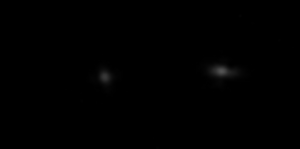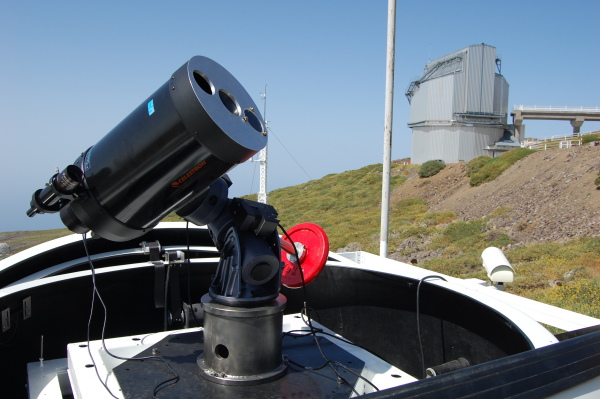The FGG-DIMM
Since 27th of February 2011 a new DIMM (Differential Image Motion Monitor) works on ORM close to TNG. The purpose of the FGG-DIMM is to provide useful information about the atmospheric conditions for the astronomical observations in the TNG's neighborhood. With this aim we have built a DIMM based on the work realized by Sarazin & Roddier (1990).
The Basis
Today the DIMM remains the most widely used instrument for measuring the seeing and the optical characterization of atmospheric turbulence. The diffraction image of a pointlike source produced by a circular pupil of diameter D, such as a telescope, is an Airy disc, which satisfies the relationship

The light emitted by a star must pass through several layers of turbulent atmosphere, characterized by inhomogeneities in the refractive-index, that disrupts the propagation of light. That is why in the focus of the telescope is impossible to reach the theoretical angular resolution, showed above, of a perfect mirror. The image of a star is degraded by atmospheric turbulence, so that its size depends primarily on the contribution of the integrated turbulence throughout the atmosphere, being almost insensitive to the diameter of the telescope. Traditionally astronomers have described this degradation from the full width at half maximum (FWHM) of a star. Experience shows dramatically that the FWHM is always larger than Airy's disc.
The DIMM method consists of measuring wavefront slope differences over 2 small pupils some distance apart. Because it is a differential method, the technique is inherently insensitive to tracking errors and wind shake. In practice, starlight goes through 2 small circular sub-apertures, cut in a mask placed at the entrance of a small telescope. One of the sub-apertures contains a prism in order to create a second image of the star on the detector. The dual star images obtained exhibit a measurable relative motion, longitudinal (l) and transversal (t), in the image plane that represents the local wavefront tilts. Our DIMM takes 300 snapshots with an exposure time of 10 miliseconds during 50 seconds in order to obtain one measurement which can be expressed in terms of an absolute seeing scale according to the formula

where r0 satisfies

with σ = standard deviation of the differences between spots' position, l = longitudinal, t = transversal, Kl = 0.541, Kt = 0.811, D = diameter of the pupils, d = interpupilar distance



Sequence of DIMM images on a seeing of 1.75 arc-sec
Description
The hardware of our DIMM consists in a telescope Celestron CGE1100 (XLT), Schmidt-Cassegrain configuration, f/10 and 2800 mm of focal length. An equatorial mount 10Micron GM2000QCI. Two pupils of 80 mm of diameter with an interpupilar distance of 198 mm. An optical wedge made of a glass BK7, with a flatness lambda/4 and 40 arc-sec of angle wedge. The CCD camera is Matrix Vision mvBlueFox with a Sony detector ICX098AL/BL, 640x480 pixels, 5.6 µm/pixel, 4.6x3.5 arc-min of FOV and a scale plate 0.432 arc-sec/pixel. The DIMM is protected with a 7ft AstroHaven Dome.
For further information about DIMM, feel free to contact with
ssq@tng.iac.es


